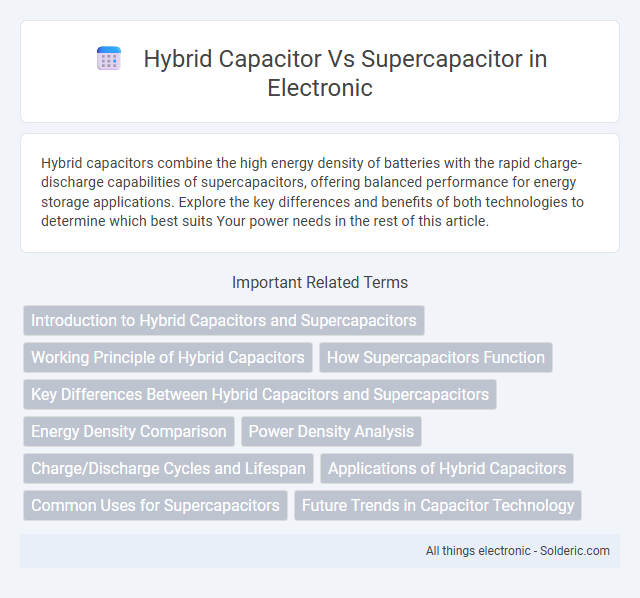Hybrid capacitors combine the high energy density of batteries with the rapid charge-discharge capabilities of supercapacitors, offering balanced performance for energy storage applications. Explore the key differences and benefits of both technologies to determine which best suits Your power needs in the rest of this article.
Comparison Table
| Feature | Hybrid Capacitor | Supercapacitor |
|---|---|---|
| Energy Density | Higher than supercapacitors (10-30 Wh/kg) | Lower than hybrid capacitors (5-10 Wh/kg) |
| Power Density | Moderate (up to 10 kW/kg) | Very high (up to 20 kW/kg) |
| Charge/Discharge Cycles | 50,000 to 100,000 cycles | Over 1 million cycles |
| Electrolyte Type | Organic electrolytes | Aqueous or organic electrolytes |
| Electrode Materials | Combination of battery-type and capacitive electrodes | Carbon-based electrodes (activated carbon, graphene) |
| Applications | Energy storage in hybrid vehicles, backup power | Power backup, regenerative braking, energy harvesting |
| Voltage Range | 2.7 - 3.8 V | 2.3 - 2.7 V |
| Cost | Higher due to complex materials | Lower, widely available materials |
Introduction to Hybrid Capacitors and Supercapacitors
Hybrid capacitors combine the high energy density of batteries with the high power density of capacitors by integrating faradaic and non-faradaic energy storage mechanisms. Supercapacitors, also known as ultracapacitors, store energy through electrostatic charge accumulation on the electrode surface, providing rapid charge and discharge rates with exceptional cycle life. Both devices are used in energy storage applications requiring fast energy delivery, but hybrid capacitors typically offer higher energy densities compared to traditional supercapacitors.
Working Principle of Hybrid Capacitors
Hybrid capacitors combine the electrostatic energy storage of traditional capacitors with the electrochemical energy storage of batteries, utilizing a battery-type Faradaic electrode and a capacitor-type electrode. Your energy storage system benefits from higher energy density compared to supercapacitors, as hybrid capacitors store charge through both ion adsorption and redox reactions. This dual mechanism allows for faster charge-discharge cycles with better durability and improved performance in high-power applications.
How Supercapacitors Function
Supercapacitors function by storing energy through electrostatic charge separation in an electric double layer at the electrode-electrolyte interface, enabling rapid charge and discharge cycles. Unlike hybrid capacitors, which combine battery-like faradaic reactions with capacitive storage, supercapacitors rely purely on non-faradaic processes for high power density and extended cycle life. The ability of supercapacitors to deliver fast bursts of energy with minimal degradation makes them ideal for applications requiring quick energy delivery and long-term reliability.
Key Differences Between Hybrid Capacitors and Supercapacitors
Hybrid capacitors combine the high energy density of batteries with the high power density and long cycle life of supercapacitors, utilizing asymmetric electrodes such as a battery-type electrode paired with a capacitor-type electrode. Supercapacitors, also known as ultracapacitors, primarily store energy through electrostatic double-layer capacitance, resulting in faster charge-discharge cycles and higher power density but lower energy density compared to hybrids. The key differences lie in their electrode materials, energy storage mechanisms, voltage windows, and typical applications, with hybrids often used where higher energy storage is needed and supercapacitors favored for rapid energy delivery.
Energy Density Comparison
Hybrid capacitors offer higher energy density compared to conventional supercapacitors by combining battery-like electrodes with capacitor electrodes, allowing energy storage typically between 10 to 30 Wh/kg. Supercapacitors generally exhibit lower energy densities, around 5 Wh/kg, due to their reliance on electrostatic charge storage mechanisms. The enhanced energy density of hybrid capacitors makes them more suitable for applications requiring longer energy delivery times while maintaining high power capabilities.
Power Density Analysis
Hybrid capacitors offer higher power density compared to traditional supercapacitors due to their combined electrochemical and electrostatic energy storage mechanisms. This enhanced power density allows your devices to deliver rapid energy bursts while maintaining longer cycle life and stability. Optimizing power density in hybrid capacitors makes them ideal for applications requiring quick charge and discharge rates with sustained performance.
Charge/Discharge Cycles and Lifespan
Hybrid capacitors offer a balanced charge/discharge cycle life, typically ranging from 100,000 to 1,000,000 cycles, while supercapacitors can exceed 1,000,000 cycles, providing superior longevity. Your choice impacts the lifespan, as hybrid capacitors combine battery-like energy density with capacitor-like power density but may degrade faster under extreme conditions. Supercapacitors maintain stable performance over extended cycles, making them ideal for applications requiring long-term reliability and frequent charge/discharge events.
Applications of Hybrid Capacitors
Hybrid capacitors offer a balanced combination of energy density and power delivery, making them ideal for applications such as renewable energy systems, electric vehicles, and backup power supplies. Their ability to efficiently store and release energy supports grid stabilization and regenerative braking systems, enhancing overall performance and lifespan in these contexts. You can rely on hybrid capacitors to optimize energy management in advanced electronics and transportation technologies.
Common Uses for Supercapacitors
Supercapacitors are commonly used in applications requiring rapid charge and discharge cycles, such as in regenerative braking systems in electric vehicles, backup power supplies, and memory retention during power interruptions. Their high power density and long cycle life make them ideal for smoothing power fluctuations in renewable energy systems and powering wearable electronics. Hybrid capacitors blend features of batteries and supercapacitors but are less prevalent in these rapid energy delivery roles compared to traditional supercapacitors.
Future Trends in Capacitor Technology
Hybrid capacitors combine the high energy density of batteries with the rapid charge-discharge capabilities of supercapacitors, positioning them as a key technology for future energy storage solutions. Advances in materials such as graphene and novel electrode composites are enhancing the performance, lifespan, and scalability of both hybrid capacitors and supercapacitors. Your choice between these technologies will depend on specific application demands, particularly in electric vehicles, renewable energy systems, and portable electronics where efficiency and fast energy delivery are crucial.
Hybrid capacitor vs supercapacitor Infographic

 solderic.com
solderic.com